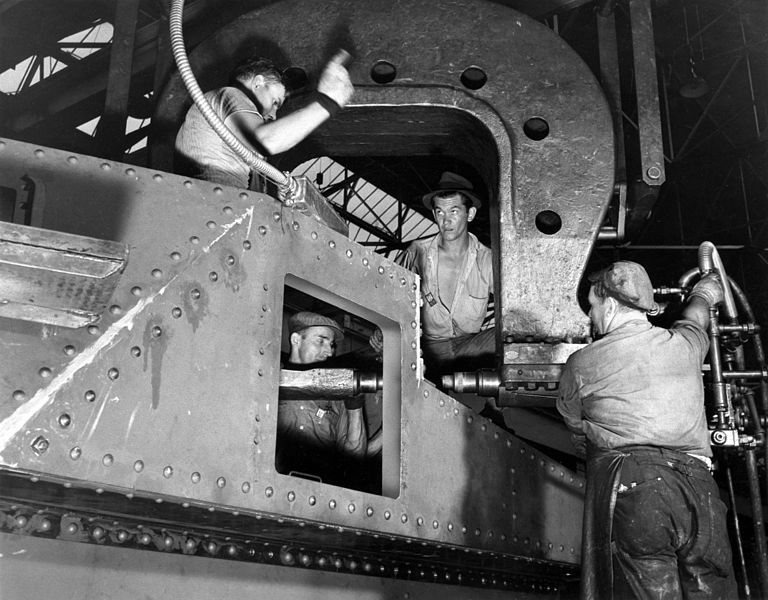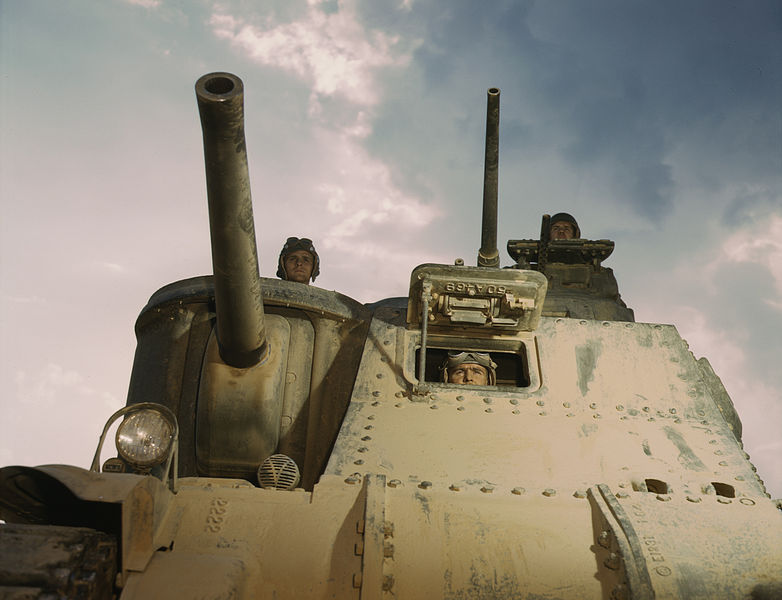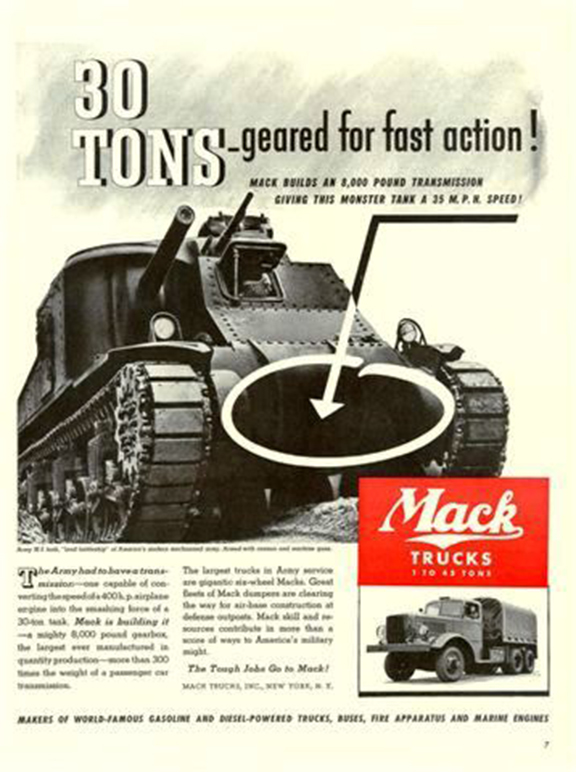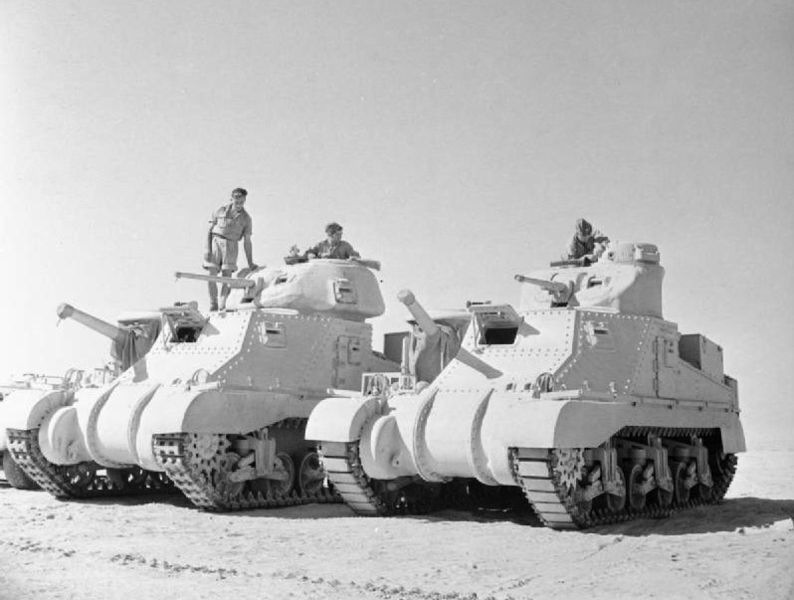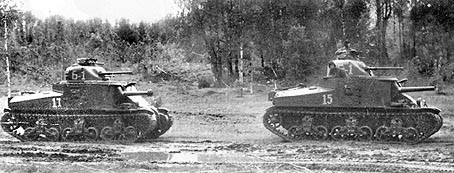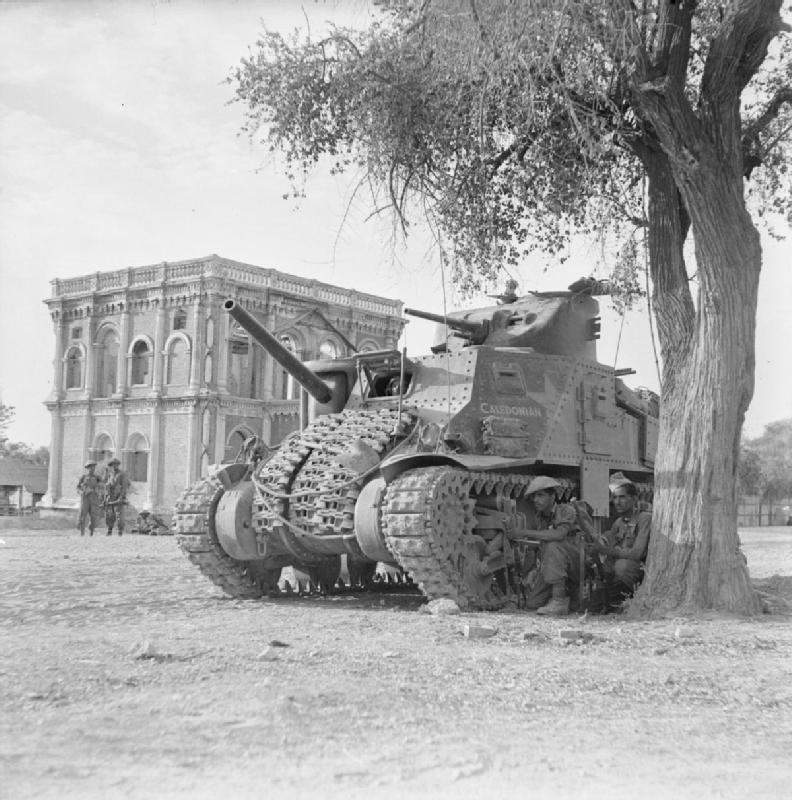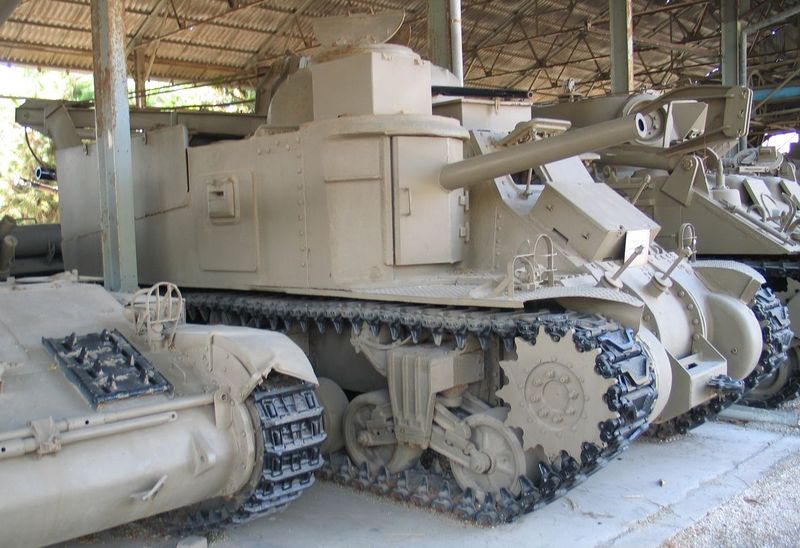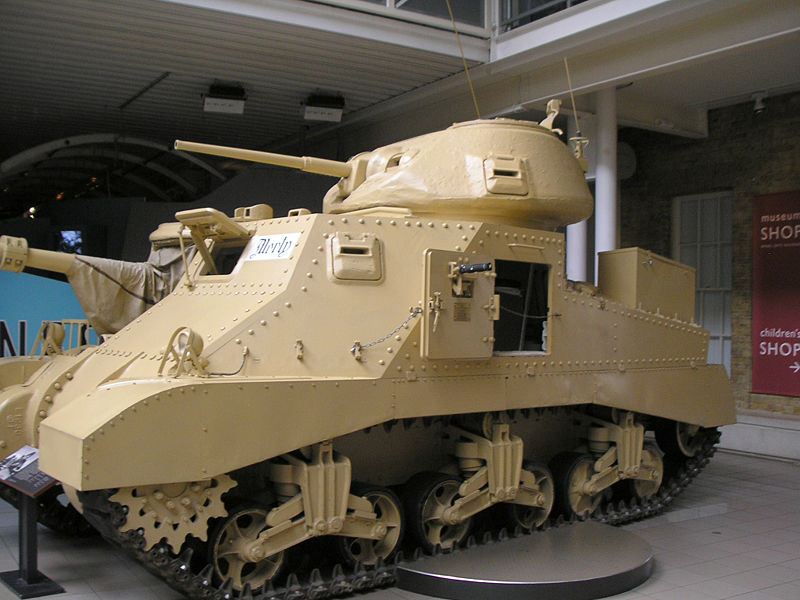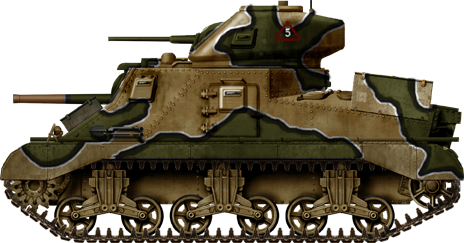A Lend-Lease stopgap tank
If the Lee/Grant never achieved the fame of the Sherman, this was due to its very roots and the role it played during the war. Born as a replacement for the unsuccessful M2 Medium Tank (1938), which never left the American soil, the M3 was designed and equipped in a rush. When war broke out in Europe in 1939, the USA was far from ready to enter the fray. Its tank design was evolving through a peacetime, post-crisis context, and tactical thinking was inherited from WWI. 400 tanks were available then, mostly light M2 models.
The result of the blitzkrieg in France came as a real surprise, and immediately triggered a complete re-thinking of US tank design. Shortly after the battle of Britain was over, war was raging in North Africa. The British industry was not able to deliver enough tanks to defend both the homeland and the empire, and notably its vital crossing points, like the Suez Canal. As the Lend-Lease act was passed, on March, 11, 1941, President Roosevelt famously declared that USA should become the “arsenal of democracy”. And the M3 Lee quickly turned into its most tangible symbol.
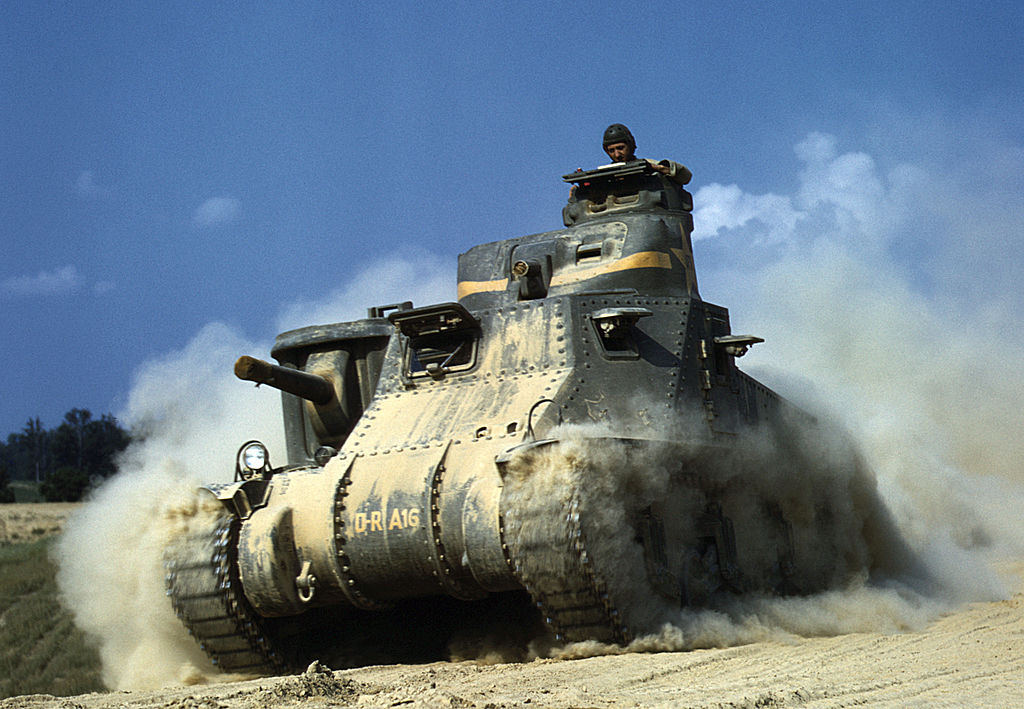
M3 Lee at Fort Knox, June 1942
Design of the M3 – The “Iron cathedral”
The M3 design process began in July 1940, as a derivative of the T5, the T5E2. By then, the M4 Sherman, a 75 mm (2.95 in) armed medium tank, was already scheduled for production. But many features, like the full rotating turret design, were far from ready and the US industrial capacity not mature enough for the required production values. The T5 design came as an interim, quickly designed and built model. The rushed designed was then required both by US Army needs and the United Kingdom’s demand for 3,650 medium tanks (by then a British proposal for US-built Crusaders and Matilda was rejected). It was basically a scaled up M2, with better armor, a much higher and wider hull, in order to mount an offset 75 mm (2.95 in) gun in a traversable sponson on the right side.
The initial plans called for a full traverse turret equipped with a single AA cal.30 (7.62 mm). The 75 mm (2.95 in) was meant to deal both with static ground targets and other tanks, with its armor-piercing projectiles and good velocity, but the 37 mm (1.46 in) gun was still favored in this role. High explosive shells were carried as well. An upper cupola was initially designed to house a cal.30 (7.62 mm) machine-gun., giving this model its cartoonish, caricatural appearance, bristling with guns in turrets and sponsons, much like a battleship. As customary for US tanks by that time, secondary armament comprised between three and eight cal.30 (7.62 mm) model 1919 machine-guns. The tracks, most of the suspension system, road wheels, return rollers, were all borrowed from the M2 to ease production. The main difference was a three bogie train and redesigned suspension.
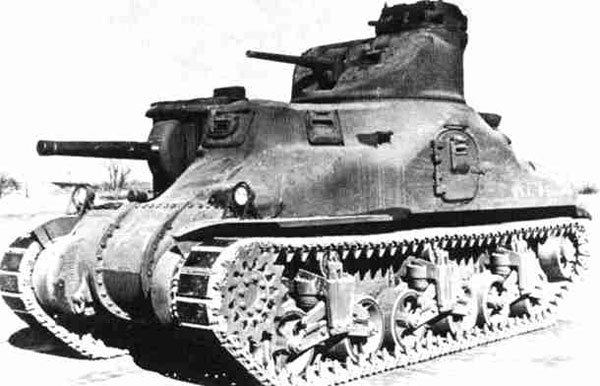
A M3A1 Lee (cast, smooth hull model). These models seem to have been too costly to be built en masse at the time. Progress would be made preceding the start of M4 production. The advantage of a cast hull was, of course, the theoretical time-saving assembly and less added material, meaning less weight. Both M3A2 and M3A3 reverted back to a welded, sharp angled hull.
Large and roomy, the M3 accommodated a large transmission, running through the crew compartment. It was served by a synchromesh, 5 speeds forward, 1 reverse gearbox, and steering was obtained by differential braking. The vertical volute suspension incorporated a self-contained return roller, which was no longer fixed to the hull. This feature was meant for easier maintenance and repair. The turret was geared by an electro-hydraulic system, powered by the main engine, also providing pressure for the main gun stabilizer, and the turret could make a full traverse in less than 15 sec.
The main gun was operated by a loader and gunner (with a spade grip), and targeting done through a M1 telescope, mounted right on the sponson roof. Maximal range was 2700 m (3000 yds). The M2 telescope served the secondary gun, which had a maximum range was 1400 m (1500 yds). This 37 mm (1.46 in) gun was operated with geared handwheels for traverse and elevation. Normal provision was 46 rounds for the 75 mm (2.95 in), 178 for the 37 mm (1.46 in) and 9200 for the machine-guns. Maximum configuration included machine guns mounted in the upper turret, lower coaxial, commander cupola, rear external AA mount for a single M1919 A4, and even four hull machine-guns in sponsons, fitted in the four corners of the superstructure.
In practice, they were rarely seen. The powerplant was an aircraft based Wright Continental, with high-octane gasoline, air cooled, which was also a perfect choice for a speedy production, as no dedicated engine powerful enough was available then. The upwards position of the transmission, not helped by the tall engine, which sat high on the rear part of the hull, forced the entire casemate to be raised. The overall design was incredibly tall, 10 feet (3 m) high, which later arose as its major drawback on the battlefield. The Germans nicknamed the M3 a “splendid target”, and the Americans the “iron cathedral”.
The British order
The M3 was not the initial choice of the British commission. The wooden mock-up was built when the first plans were ready, and presented in 1940. Several flaws immediately appeared, among them, a high profile, sponson gun, riveted hull, insufficient armor, and a hull mounted radio. But as production was scheduled to start quickly after the final prototype was ready, and hoping for improvements on later versions, an initial order for 1250 M3s was placed for a total 240 million dollars, and the production shared between three US companies, Pressed Steel Car, Pullman, and Baldwin. These three built the British models (soon called “Grant”, after the famous Union general), while the US models (called “Lee”, after his famous confederate antagonist) were produced by the Chrysler Detroit Tank Arsenal, and American Locomotive (ALCO) at Schenectady, New York.
The turrets were cast by Union, General Steel Casting, ASF and Continental. This explains why there were so many differing details within the two main versions -M3 and M3A1- and between the British and US models. The British prototype was ready in March 1941. It included a distinctive turret back bustle to accomodate a Wireless Set No. 19 radio, stronger armour and no machine-gun cupola, replaced by a simple hatch. The armor increase was not initially planned, but introduced as soon as new reports of German anti-tank capabilities were available. The initial crew included a driver, commander, gunner and loader, upper gunner, a machine-gun servant and a radio. The British model didn’t include the radio operator. Later, the US crew numbers were also reduced to six and even five in 1942, as the radio operator also became a gunner.
Production from the M3A1 to the M3A5
Ready as it was for mass-production, 4724 units M3s were built in the first batch, starting from mid-1941, and a second one of 1334 units was built until December 1942, named M3A1 (Lee II in British service) up to the M3A5. The M3A1 featured a cast rounded hull, with a low profile turret and slightly thicker armor. Only 300 M3A1s were built, followed by the M3A2 (Lee III), with a welded but sharp angled hull, of which only 12 units were produced. The M3A3 (also called Lee IV and V), featured a welded hull, a pair of GM 6-71 diesels, and fixed or eliminated side doors (322 units).
The M3A4 (Lee VI) had a stretched welded hull, and a new Chrysler A57 multibank engine, a strange assembly of five 6-cyl L-head car engines mated to a common crankshaft, boasting a final 21 liters for 470 bhp and a lot of torque. This was well-appreciated, as the initial model was criticized for being under-powered. Only 109 of these M3A4 were built. The last production (591 units), mostly fielded by the British army, was the M3A5, equipped with the twin GM 6-71 diesels, but with a riveted hull and Lee turret. Strangely, they were called “Grant II” in British service. Due to the many contractors involved, notably the cast turret foundries, these variants showed further variety in the shape of the hull, turret and details, notably due to different casting procedures.
M3 variants
The M3, as a basis for further developments, was incredibly successful. Not only did it allowed the next, long awaited generation M4 Sherman, to be designed and produced faster, thanks to the many parts it shared with the M3, but the same basis served also for other vehicles. These included the Canadian Ram tank, the 105 mm (4.13 in) Howitzer Motor Carriage M7, better known as the M7 Priest, 155 mm (6.1 in) Gun Motor Carriage M12, the Kangaroo armored personnel carrier, and the Sexton Mk.I self propelled gun. Many were also converted as recovery tanks, the model M31 (also called Grant ARV in British service), and the M31B1 and M31B2, based, respectively, on M3A3/A5 versions. The M31 was fitted with a dummy gun and turret, a crane and a towing apparatus with a 27 ton (60,000 lb) winch installed. The M33 Prime Mover was a conversion of former towing versions as artillery tractors (109 units in 1943-44).
The British variants were the Grant ARV, an armored recovery vehicle obtained from disarmed Grants Mk.Is and Mk.IIs, the Grant Command, equipped with map table, extra radio, and dummy guns; the Grant Scorpion III, a mine-cleaning vehicle equipped with the Scorpion III flail, and its variant the Scorpion IV; and eventually the Grant CDL, which stands for “Canal Defence Light”, featuring a powerful searchlight and a machine gun. 355 were produced in all, which were also registered in US army service as the “Shop tractor T10”. A single Australian conversion (800 had been transferred by 1942) was the BARV, a beach recovery vehicle, which used the M3 chassis. Probably the last of these versions was the Australian Yeramba Self Propelled Gun, with 12 units adapted from the M3A5 in 1949.
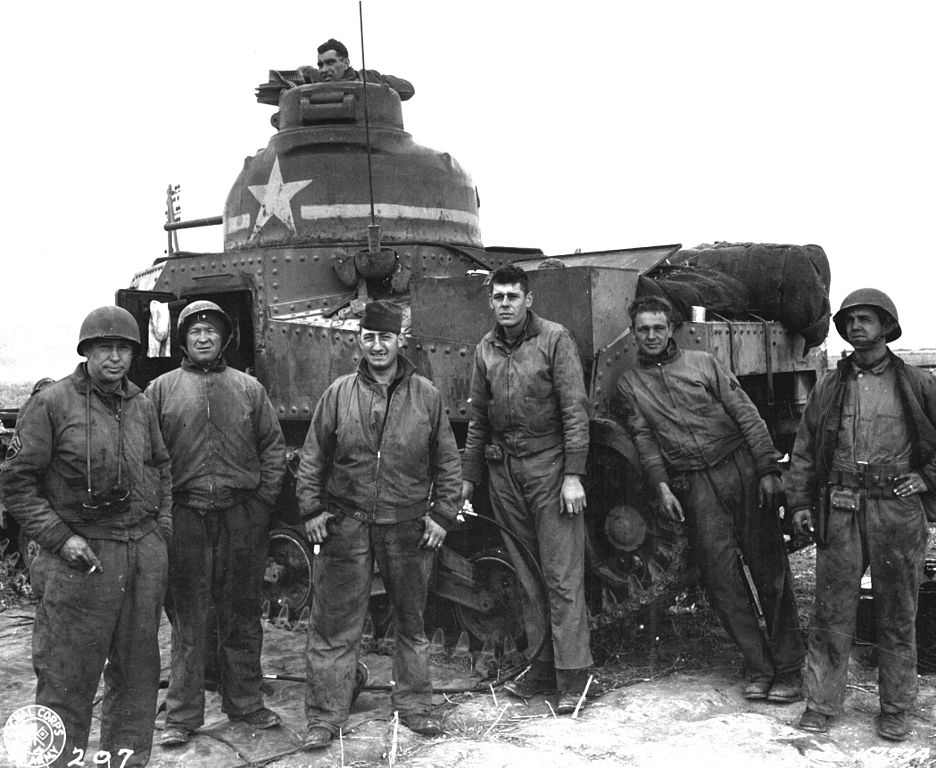
An American M3 and crew, posing at Souk-Al-Abra, Tunisia, November, 23, 1943.
The M3 in action
With a production running only one year and a half and an obsolete, awkward design, the M3 was not supposed to be a frontline tank during the entire length of the conflict. But it nevertheless saw service until the very end, thanks to some qualities, redeployment in more suitable campaign theaters, and conversions to other duties. The British, although reluctant, pushed for it since it was the only model suitable for instant mass-production, and it became the warhorse of the British VIIIth Army during 1941-42, especially during the worst period of the campaign. Although the high silhouette and main gun position were despised, the Lee/Grant was reliable, very sturdy, had good armor and, overall, generous firepower. Through Lend-Lease, 2,855 units were sold to the British and 1396 were supplied to the USSR.
The British M3 in combat
First engagement came with the disastrous battle of Gazala, which did not diminish the role played by these tanks (at that time, the main British design, the Crusader, only had a 37 mm/1.46 in gun and minimal armor). Grants and Lees were well-used in each major engagement of the African campaign, from El Alamein to the end of the Tunisian campaign, in mid 1943. By then, upgunned Panzer IIIs and IVs proved deadly and the M3 had been gradually replaced by more capable Shermans and British designs armed with the QF 6 pounder.
Since there were battle reports of the M3 throughout mid-1942 to November, when the first US forces arrived in Africa, most variants (A1 to A5) were attributed to British requirements. British M3s were sent to the India/Burma theater as soon as they received the new M4 Sherman. About 1700 transferred units gave excellent account of themselves during all the campaign, from 1943 to 1945. 800 were taken over by Australian forces, and 900 by Indian forces. They formed the bulk of the Fourteenth Army (with Indian crews), with battle honors such as the fall of Rangoon, the battle of Imphal (proving pivotal in their task), were they battered out the Imperial Japanese Army’s 14th Tank Regiment.
The US Army M3 in combat
The baptism of fire of the US Army M3 came during operation Torch, under light opposition from Vichy French forces, but they were more heavily tested during the race for Tunis in December, and the battle of Kasserine Pass. By then, only one operational unit was equipped with M3s, The 2/13th Armored Regiment of the 1st Armored Division. The last surviving units had been replaced by M4s at the beginning of 1943. Ironically, many depleted units equipped with M4 were reequipped with M3s, notably the 3/13th Armored regiment. The other unit entirely equipped with M3s was the 751st Tank Battalion of the 34th Infantry Division. By the time of Operation Husky (campaign of Sicily), the M3 was still in use by these units, but once again, the losses were replaced by M4s, and by mid-1943, all M3s in this sector had been phased out from active units.
In the Pacific theater, a single unit equipped with M3s, the 193rd Tank Battalion, deployed its M3A5s fitted with wading gear in Butaritari, part of the Makin atoll (Gilberts Islands), in November 1943, for infantry support against pillboxes and the rare Japanese light tanks encountered. None were ever used by the US Marine corp. In March 1944, US army ordnance declared the M3 obsolete. Most M3s were converted for other uses, cannibalized for spare parts, affected to drilling center units. For its odd-looking appearance, the M3 was shown in movies like 1943’s Sahara, starring Humphrey Bogart, and in its remake in 1992, and in 1979 in Spielberg’s 1941. Perhaps 50 have survived until today in various museums and private collections, including a dozen in running conditions.
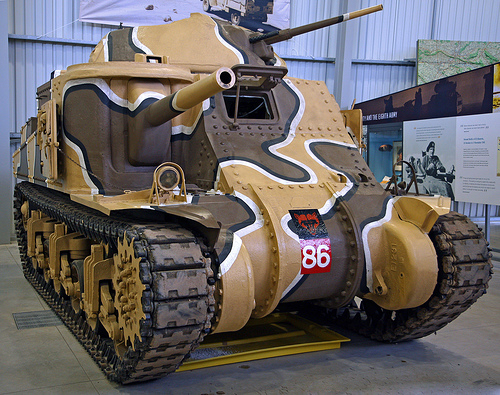
A Grant I painted in the El Alamein VIIIth army style, November 1942, at Bovington.
The Soviet M3s in combat
Part of the Lend-Lease plan, a shipment of 1300+ M3A3s and M3A5s (diesel versions) were convoyed to Murmansk and put in operational use by Soviet armored brigades, notably around Leningrad and Stalingrad. But they quickly realized this model was not a winner and, after one year of hard fighting, the surviving ones (infamously called “collective grave for six people”) were retired from front-line operations and shipped to quieter or less well-defended sectors, like the Arctic front. There, they took part in the Lista and Petsamo-Kirkenes offensives, where they encountered second-rate German tanks, mostly former French captured models. Some M3s were also captured by the Wehrmacht in 1942, and served as Panzerkampfwagen M3(r).
M3 Lee/Grant links
The M3 Lee/Grant history on Wikipedia
For modelers, by Steve Zaloga
M3 Lee specifications |
|
| Dimensions | 18ft 6in x 8ft 11in x 10ft 3in(5.64×2.72×3.12 m) |
| Total weight, short | 30 tons |
| Crew | 7(Lee)-6(Grant) |
| Propulsion | Wright Continental R975 EC2 340/400 hp |
| Speed | 26 mph (42 km/h) road 16 mph (26 km/h) off-road |
| Range | 195 km (121 mi) at medium speed (19 mph/30 km/h) |
| Armament | Main: 75 mm (2.95 in) M2/M3 in the sponson Secondary: 37 mm (1.46 in) M4/M5 in the turret 2-4 cal.30 (7.62 mm) M1919 machine-guns |
| Armor | From 30 to 51 mm (1.18-2 in) |
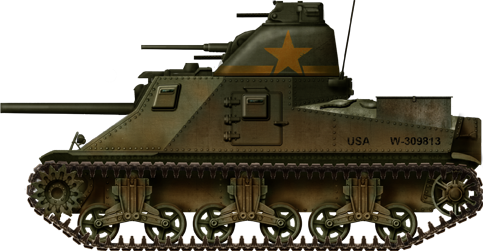
M3 Lee, early production model, belonging to the 13th Armoured Regiment, belonging to the First Armoured Division, attached to the First Infantry Division (the “Big Red One”). North Africa, Souk El-Abra, November 1942. Many M3s had been part of Operation Torch. It was then the main US medium tank.
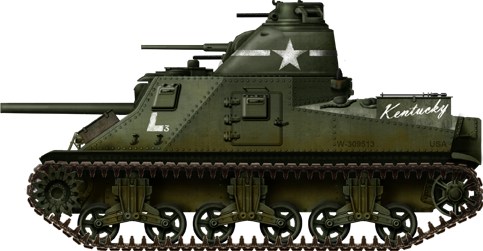
M3 Lee number three “Kentucky”, belonging to the F Company, 2nd US Tank Battalion, 13th Armored Regiment, attached to the First Armoured Division, Oran, December 1942. Notice the early initial long caliber model. The muzzle blast had a tendency to provoke excessive vibrations inside the hull.
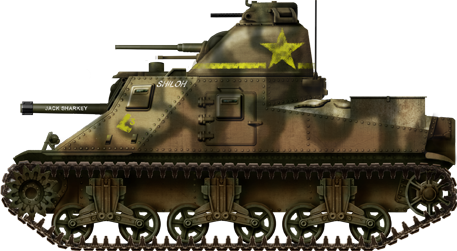
M3 Lee “Jack Sharkey” of the First Company, 13th Armored Regiment, 1st Armored Division – Tunisia, August 1943. The shorter M2 gun was mounted due to a lack of M3 guns. The end of the barrel features a compensating weight (that is not a muzzle brake), added because the stabilizer was designed for the longer barreled M3.
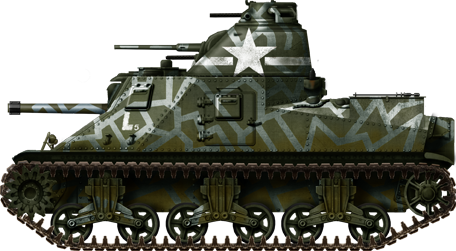
M3 Lee of the F Company, 12th Battalion, 3rd Regiment of the First Armored Division – Tunisia, February 1943. The camouflage was an attempt of “razzle-dazzle” for desert warfare.
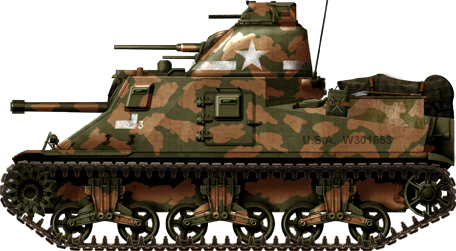
M3A2 Lee of the 13th Armored Regient, 1st AD in Tunisia, January 1943. The improvised camouflage was made of irregular spots of soft sand mixed with adhesive paint over factory olive drab.
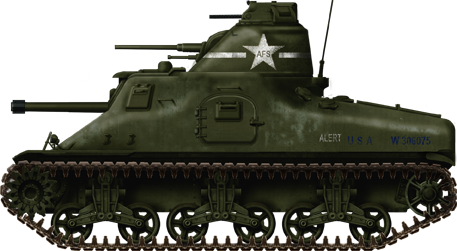
M3A1 Lee of the Armored Force School at Fort Knox, Kentucky, 1942.
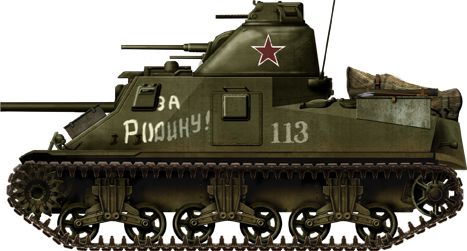
M3A3 Lee, Lend-Lease disesel version, unknown unit, Leningrad front, October 1943. Marking: “Za Rodinu”, “For the motherland”.
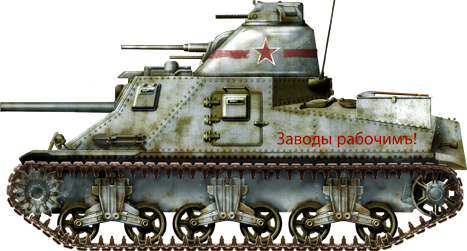
M3A5 Lee 241st Armored Brigade, Stalingrad sector, October 1942.
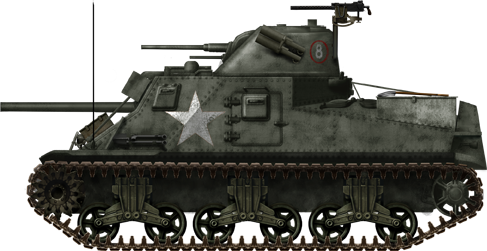
M3A5 Lee in Burma, C Squadron, 3rd Carabiniers regiment.
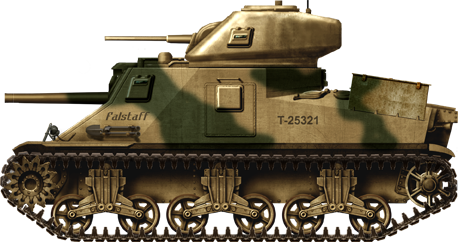
M3A3 (Lee IV), unknown unit, First Battle of El Alamein, June 1942.
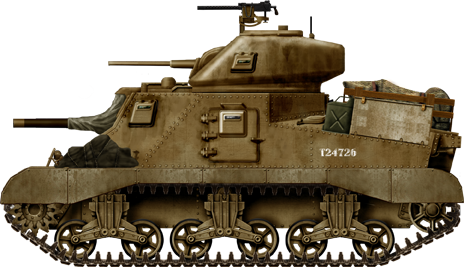
Grant Mk.I (based on the M3), Eight Army, Gazala, June 1942.
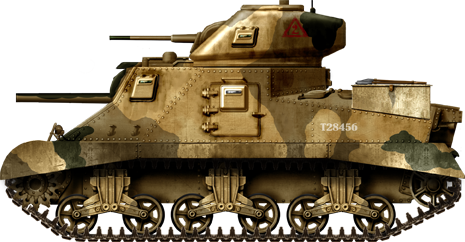
Grant Mk.I, unknown unit, VIIIth army, Egypt, May 1942. Note the tri-tone camouflage.
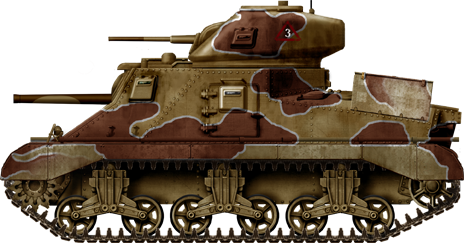
Grant Mk.I, VIIIth army, Gazala, June 1942. The camouflage was a classical spotted pattern bordered by white.
Grant Mk.II (based on the diesel M3A5), Eight Army, El Alamein (second battle), November 1942. The camouflage is similar to the patern above, with khaki variant and blackened borders for accentuated contrast.
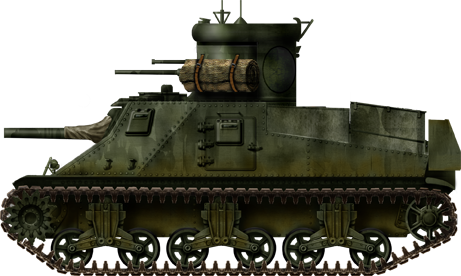
M3 Lee converted as Canal Defence light (CDL), with projector. The upper turret was replaced by an armoured searchlight, and bears a dummy gun. They had been based around Belgian canals in 1944, but never had the occasion to fight.
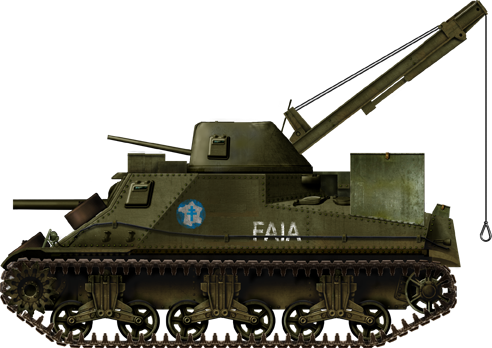
A T3 ARV (Armored Recovery Vehicle), converted from the M3 Lee, using the turret ring to hold the rig and crane apparatus. A dummy gun was welded on it. This vehicle is part of the Free French 2nd Armored Division (General De Lattre de Tassigny), operating in France in August 1944, following the Anvil Dragon landings in Provence.

WW2 Tanks




























WW2 tanks posters

All Tiger tanks liveries.

Panther liveries and variants

WW2 Armour - All tanks











Tanks aces and single tanks series

Find more there

Museums, Movies, Books & Games
The Tanks and Armor in pop culture
Tanks and armored vehicles in general are only really grasped when seen first person: The mass, the scale, it's all there. Explore also the way tanks were covered in the movie industry, in books and in video games.Movies:
Best tanks movie on warhistoryonline.com
On imdb.com
On bestsimilar.com/
miltours.com
liveabout.com/
watchmojo.com
Video Games:
pcgamesn.com
historyhit.com
levvvel.com
vg247.com/best-tank-games
mmobomb.com/
alienwarearena.com


